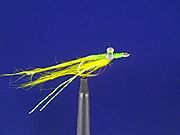Origin
Charlie Smith was a renowned Bahamian bonefish guide operating Charlie's Haven resort on Behring Point, Andros Island in the early 1970s. The resort catered to celebrity and well heeled anglers seeking Bonefish on the flats of Andros, Island. Although stories vary as to the actual creation of the Crazy Charlie, credit is given to Bob Nauheim, founder of Fishing International, a global sport fishing travel agency based in Santa Rosa, California. Nauheim had fished with Charlie Smith on a number of occasions when during a 1977 trip, he crafted the first Crazy Charlie bonefish flies to imitate small glass minnows by adding bead chain eyes. The original patterns proved successful on Andros Island bonefish so Nauheim and Charlie Smith christened the original flies "Nasty Charlie's". [2] When Charlie Smith saw Nauheim's flies for the first time, he is said to have remarked: "dat fly is nasty mon", thus the original name. Other accounts credit Charlie Smith with the original creation which was then shared with Nauheim. [3]
Nauheim took the pattern home to Santa Rosa and showed them to Leigh Perkins, the owner of Orvis outfitters. Perkins liked the pattern and added it to the Orvis catalog and began popularizing it for bonefish and permit. Perkins did not like the name "Nasty Charlie" so the name was changed to Crazy Charlie with Charlie Smith's permission. The pattern rapidly became one of the most popular flies for bonefish, permit and other saltwater flats species as well. [4]

Fly fishing is an angling method that uses a light-weight lure—called an artificial fly—to catch fish. The fly is cast using a fly rod, reel, and specialized weighted line. The light weight requires casting techniques significantly different from other forms of casting. The flies may resemble natural invertebrates, baitfish, or other food organisms.
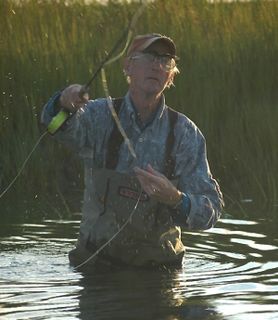
John Clarence "Jack" Gartside was an American fly tyer and fly fishing author.

Fly tying is the process of producing an artificial fly used by fly fishing anglers to catch fish. Fly tying is a manual process done by a single individual using hand tools and a variety of natural and manmade materials that are attached to a hook. Although the recent history of fly tying dates from the middle 1800s, fly tyers were engaged in tying flys since at least 200 AD.

The Woolly Bugger is an artificial fly commonly categorized as a wet fly or streamer and is fished under the water surface. It is a popular and widely used pattern for both freshwater and saltwater game fish and is generally listed as one of the top patterns to have in any fly box. John Gierach, a noted fly fishing writer discussed the Woolly Bugger first in his chapter on streamers in Good Flies. Woolly Buggers are typically fished in streams, rivers, ponds, lakes, and tidal flats. Today, Woolly Buggers are tied in a wide variety of styles and colors to imitate a wide range of game fish prey.
The Woolly Bugger is so effective, it should be banned from some watersheds. I suspect its effectiveness is due to its resemblance to so many edible creatures in the water—nymphs, leeches, salamanders, or even small sculpins. Its tail undulating behind a fiber, bubble-filled body is just too much for most fish to resist. It just looks like a meal!

The Clouser Deep Minnow is an artificial fly commonly categorized as a streamer and is fished under the water surface. It is a popular and widely used pattern for both freshwater and saltwater game fish and is generally listed as one of the top patterns to have in any fly box, especially for bass and saltwater flats fishing.

An artificial fly or fly lure is a type of fishing lure, usually used in the sport of fly fishing. In general, artificial flies are an imitation of aquatic insects that are natural food of the target fish species the fly fishers try to catch. Artificial flies are constructed by fly tying, in which furs, feathers, thread or any of very many other materials are tied onto a fish hook.
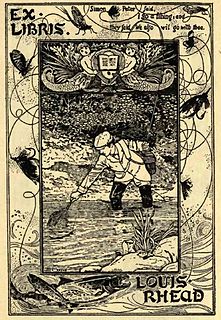
This general annotated bibliography page provides an overview of notable and not so notable works in the English language regarding the sport of fly fishing, listed by year of first publication. Although not all the listed books are devoted exclusively to fly fishing, all these titles contain significant fly fishing content. The focus of the present page is on classic general texts on fly fishing and its history, together with notable public or university library collections dedicated to fly fishing.
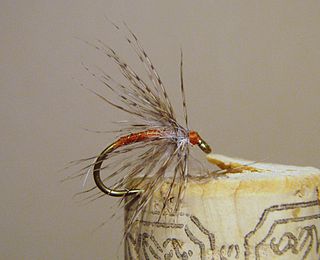
The Partridge and Orange is an artificial fly commonly categorized as a wet fly or soft hackle and is fished under the water surface. The fly is a very well known fly with its roots set firmly in English angling history. It is an impressionistic pattern fished successfully during caddis hatches and spinner falls. The Partridge and Orange is traditionally a trout and grayling pattern but may be used for other aquatic insect feeding species.

The Royal Coachman is an artificial fly that has been tied as a wet fly, dry fly and streamer pattern. Today, the Royal Coachman and its variations are tied mostly as dry flies and fished floating on the water surface. It is a popular and widely used pattern for freshwater game fish, particularly trout and grayling. Large streamer versions are also used for winter steelhead and Atlantic salmon.
Bernard "Lefty" Kreh was an American fly fisherman, photographer and fly casting instructor who resided most recently in Hunt Valley, Maryland. Kreh is most known for being one of the pioneers of saltwater fly fishing and his book, Fly Fishing in Salt Water, is considered the seminal volume on the subject.
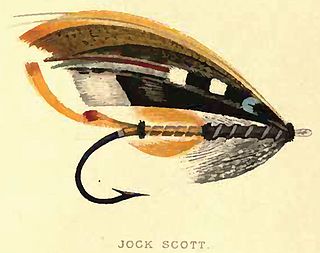
Fully dressed flies are elaborate and colorful artificial flies used in fly fishing. The most famous of these are the classic salmon flies, which are exquisite patterns made from mostly rare and beautiful materials and feathers, including golden pheasants, toucans, swans, and ivory-billed woodpeckers. These flies have been popular in the United Kingdom since the 19th century. Fully dressed flies are often meant for display and are not used in actual fishing. Many patterns are expensive to tie because of the cost of rare feathers.
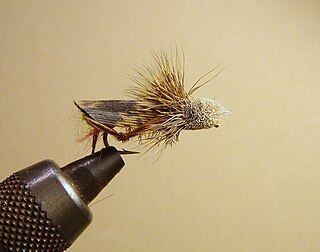
Dave's Hopper is an artificial fly used for fly fishing, designed to imitate adult grasshoppers and other Orthoptera species. It is considered a dry fly terrestrial pattern. It was designed by fly tyer and angler Dave Whitlock, and combines the best aspects of Joe's Hopper and Muddler Minnow patterns.
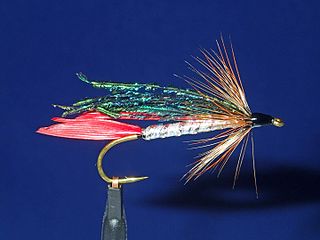
The Alexandra wet fly originated in Scotland in the 1860s. The artificial fly is also known as the Lady of the Lake, the fly was named by English angler Major William Greer Turle to honor Alexandra, Princess of Wales. The fly is distinguished by the heavy peacock herl wing and silver body which makes the fly resemble a small baitfish or fry. The Alexandra proved to be a very effective fly for trout in lakes and streams in England and Scotland in the late 19th and early 20th century. Many fly fishing purists derided the fly and its use was once banned on many English waters.
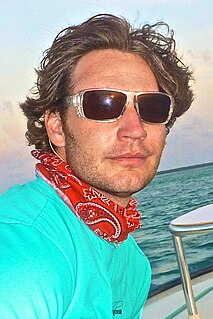
Andrew "Drew" Chicone is an American author, saltwater fly designer, fly fisherman and fly casting instructor. He writes books and magazine articles demonstrating how to tie saltwater fly patterns, primarily focused on warm-water fish and fly fishing from standup paddleboards.

The Lefty's Deceiver is an artificial fly streamer pattern used in fly fishing for freshwater and saltwater species. The fly was originated by fly angler and author Lefty Kreh in the Chesapeake Bay for striped bass. The original fly was tied to resemble smelt, a common striped bass forage. The Deceiver is arguably the best known saltwater fly pattern in the world and in 1991 the U.S. Postal Service honored Kreh’s creation with a postage stamp.

Surf Candy is style of artificial fly used primarily in saltwater fly fishing to imitate small sand eels and other small baitfish. The style was developed by American fly tier Bob Popovics in the 1970s for bluefish, tuna and striped bass on the Atlantic coast.
Manufacturers of fly tying materials and tools produce products specifically designed for tying artificial flies used in fly fishing. For the most part, the materials and tools from manufacturers are sold to fly tyers through fly fishing retail outlets, both brick and mortar and online stores that buy in bulk from the manufacturers. The manufacturing companies are headquartered primarily in the United States, United Kingdom, Japan, Italy, France, and China. The types of materials and tools that are produced include specialized fly tying hooks, metal and glass beads, feathers, thread, dubbing, tinsel, wire, chenille, fly tying vises, tools to assist in manipulating materials, and a variety of other synthetic materials used in fly tying. Processing of animal hair and fur for fly tying, as well as hand tied flies is done on a smaller scale by independent companies or professional fly tyers.

The Wulff series of dry flies evolved from a dry fly style conceived by angler Lee Wulff in the 1930s.

The Humpy fly is a popular and effective dry fly used by fly anglers for trout in fast-water conditions.
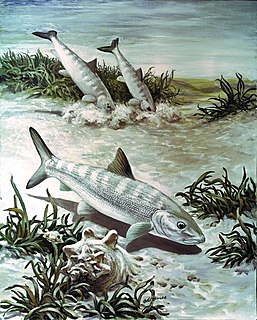
Bonefish fly patterns are a collection of artificial flies routinely used by fly anglers targeting various species of Bonefish. Bonefish frequent tidal sand and mudflats in tropical and sub-tropical latitudes to feed on benthic worms, fry, crustaceans, and mollusks. Bonefish have small mouths and most Bonefish flies are tied on size 4 to 8 saltwater fly hooks.



